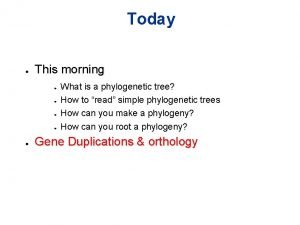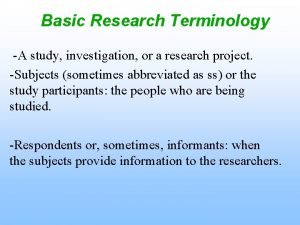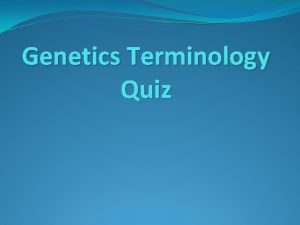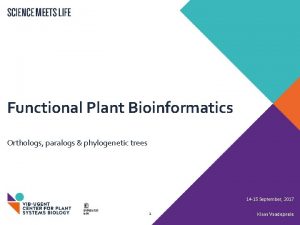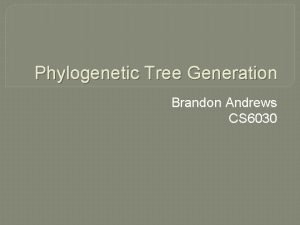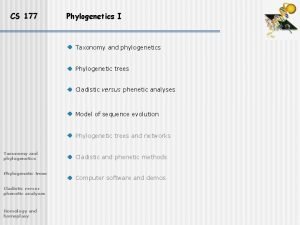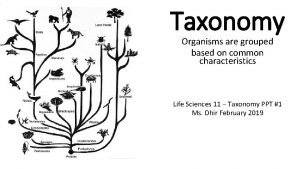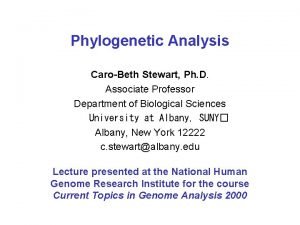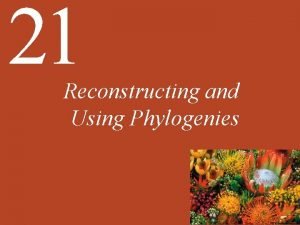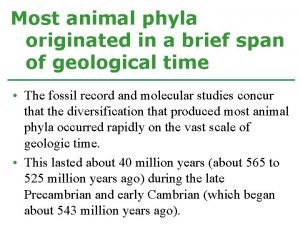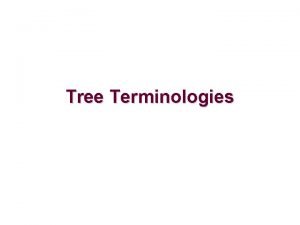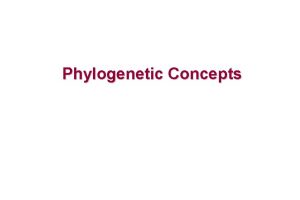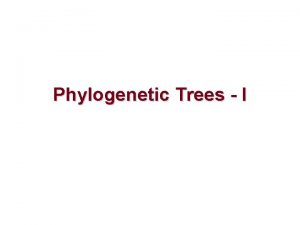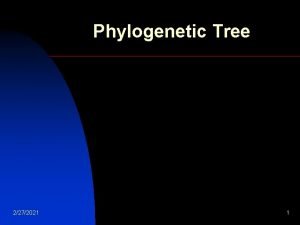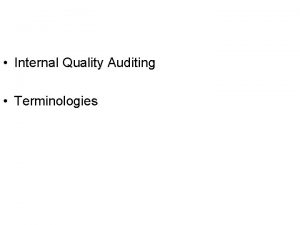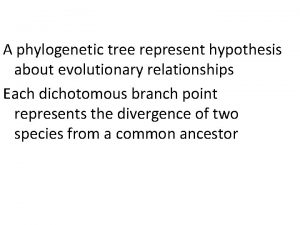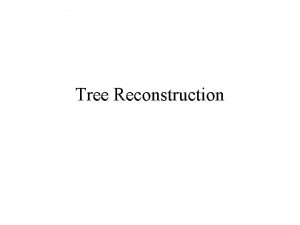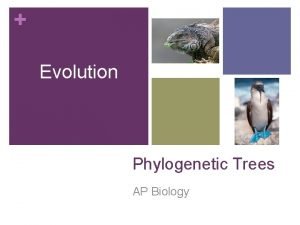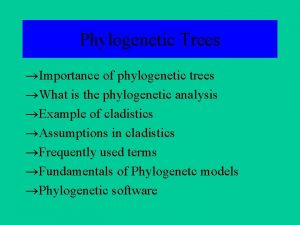Tree Terminologies Phylogenetic Tree phylogenetic relationships are normally


















- Slides: 18

Tree Terminologies

Phylogenetic Tree - phylogenetic relationships are normally displayed in a tree-like diagram (phylogenetic tree/cladogram) - a cladogram is a branching diagram describing the phylogenetic relationships of the taxa under investigation. - a cladogram consists of two major elements: nodes and branches. - a node represents a taxon; a branch represents evolutionary event(s). - the branching pattern of a cladogram is called the topology.

terminal nodes (leaves) A B terminal branches C D E F G H I J internal nodes polytomy internal branches root A cladogram

Cladogram/Phylogram/Phenogram Cladogram Phylogram

Cladogram/Phylogram/Phenogram - A cladogram/phylogram displays branching information to explain the evolutionary relationships. - A phylogram has additional information: the length of branches according to the amount of changes (evolutionary process). - A phenogram is generated from phenetic analysis. It does not necessary explain the ancestordescendant relationships of the taxa in the investigation.

Trees are like mobiles The edges of tree can be freely rotated without changing the relationships among the terminal nodes. = =

Bifurcating and Multifurcating Trees When all the internal nodes in a cladogram are connected to three different nodes, the cladogram is said a bifurcating tree. When one or more internal nodes in a cladogram are connected to more than three different nodes, the cladogram is a multifurcating tree. The internal node is referred as polytomy. polytomies Bifurcating trees Multifurcating trees

Polytomy polytomies - Polytomy explains unresolved relationship of taxa. - Polytomies can represent two different situations: ?

Polytomy polytomies - Polytomy explains unresolved relationship of taxa. - Polytomies can represent two different situations: i) simultaneous divergence – all the descendants evolved at the same time (a “ hard” polytomy) ii) uncertainty of phylogenetic relationships or lack of resolution due to insufficient data (a “soft” polytomy)

Polytomy “hard” polytomy (simultaneous divergence) “soft” polytomy (uncertainty) or or……

Rooted and Unrooted Trees - Unrooted tree explains phylogenetic relationshiops of taxa. Rooted tree explains phylogenetic relationships of taxa and also the direction of evolution of the taxa. - Root is located at the base of a phylogenetic tree. It represents the immediate ancestor to all the terminal taxa of the tree. root Unrooted tree Rooted tree

Tree Rooting unrooted tree 1 rooted tree 3 rooted tree 2 rooted tree 4 rooted tree 6 rooted tree 5 rooted tree 7

Number of taxa Number of unrooted tree Number of rooted tree 2 1 1 3 4 3 15 5 15 105 6 105 945 7 945 10, 395 8 10, 395 135, 135 9 135, 135 2, 027, 025 10 2, 027, 025 34, 459, 425

Shorthand for Trees can be represented by a shorthand notation that uses nested parentheses. Each internal node is represented by a pair of parentheses that enclose all descendants of that node. This format makes it easy to describe a tree in the body of some text without having to draw it. The format is also used by many computer programmes to store trees in data files. A B C D E (((A, B), C), (D, E))

Give a shorthand tree for the cladogram below. A B C D E F G H I J A CLADOGRAM

Give a shorthand tree for the cladogram below. A B C D E F G H I J A CLADOGRAM (((A, B), C), ((D, E), ((F, G), (H, I, J))))

Sister taxa/group Sister group(s) i) In cladistics two taxa or clades which meet at a node; or in other words two lineages which diverged from that particular common ancestor. Because sister groups share a common ancestor, they are each other's closest relatives. ii) Evolutionary theory: The two clades resulting from the splitting of a single lineage. iii) a species or higher monophyletic taxon that is hypothesized to be the closest genealogical relative of a given taxon exclusive of the ancestral species of both taxa.

Sister taxa/group A B C D Sister taxa/group of (F, G)? Sister taxa/group of B? Sister taxa/group of C? Sister taxa/group of (D, E, F, G)? E F G H I J
 Mikael ferm
Mikael ferm Normally white vs. normally black
Normally white vs. normally black Species tree
Species tree Technical terms in research example
Technical terms in research example Security terminologies and principle
Security terminologies and principle Basic research terminology
Basic research terminology Itsm terms and terminologies
Itsm terms and terminologies Homozygous dominant
Homozygous dominant Ethical hacking terminologies
Ethical hacking terminologies Orthologs and paralogs in phylogenetic tree
Orthologs and paralogs in phylogenetic tree Phylogenetic tree of a dog
Phylogenetic tree of a dog Upgma tree generator
Upgma tree generator Scaled and unscaled phylogenetic trees
Scaled and unscaled phylogenetic trees Phylogenetic tree amoeba sisters
Phylogenetic tree amoeba sisters Unrooted phylogenetic tree
Unrooted phylogenetic tree Ingroup phylogenetic tree
Ingroup phylogenetic tree Building a phylogenetic tree activity
Building a phylogenetic tree activity Acoleomate
Acoleomate Unrooted phylogenetic tree
Unrooted phylogenetic tree


